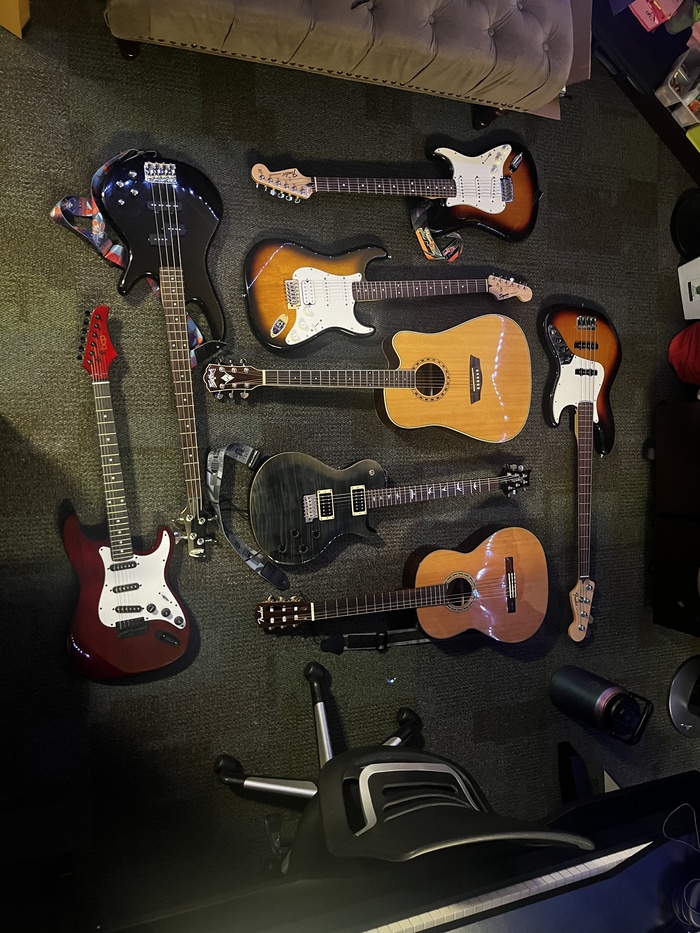hello community!
I am not a guitarist at all whatsoever, but I’ve been task at the school studio to take care of the instruments inside of the studio, and that includes guitars. I’ve only ever change the strings on any guitar, maybe five or six times so never really got to practice it, but I have several different types of guitars in this scenario and realize that I’m not quite sure how to approach changing the strings for each of the kinds.
I was wondering if any guitar enthusiast here could help me figure out how to best approach changing all the strings (As they haven’t been in a long time) And helping me see what tools, resources, and maintenance expectations I should have as I begin to learn a bit more about this concept.
Here's the names to most of these guitars:
4 string bass - gio ibanez sound gear
4 string bass - fender jazz bass
acoustic guitar - fender CN140S NAT
acoustic guitar - WD10CE
ELECTRIC GUIT. - squire bullet strat
ELECTRIC GUIT - Fender stratocaster
ELECTRIC GUIT - prs se tremonti
ELECTRIC GUIT - BCP (this is a student guitar. I'm not really familiar with this brand... i think it's a starter guitar but I'm not 100% sure)
strings in stock:
D’addario Classic Nylon - 5 full sets
D’addario EJ16-3D - 8 full sets, 3 incomplete ones
D’addario EJ16 - 8 full sets
D’addario XL - 0 sets
Martin & Co. Strings SP 80/20 Bronze - 0 full sets, only has 6th-2nd String
Elixir Nickel Plated Steel Polyweb Coating Light - 0 full sets, only 46 & 36
Elixir Nickel Plated Steel Optiweb Coating Medium - 0 full sets
question one: What kind of strings do you recommend for the type of guitars that I have?
Question two: is it possible to use the particular sets that I have? I should be keeping these just in case a singular string pops off, and I can replace them, correct?
question three: how do you go about learning how to set the appropriate action, tension, and strength type, gauge type and material depending on the guitar and the player, genre or a bit all three? Is this something that you learn overtime or is there a specific resource that I can tap into to get a better understanding?
question four: What tools do I need to efficiently and quickly change the strings on a guitar and set the appropriate action?
Question five: are there any other items I should get so that I can take care of the guitars on a consistent basis such as the string cleaner and conditioner that I have?
Question six: After the strings are changed, should I expect? a change into Tonality? Is there a wear in period? should players take caution with anything in specific after guitars strings are changed?
Question seven: How do I know if a guitar string is slipping or if the tuning pegs are appropriately working?
Any advice is greatly appreciated!
I am not a guitarist at all whatsoever, but I’ve been task at the school studio to take care of the instruments inside of the studio, and that includes guitars. I’ve only ever change the strings on any guitar, maybe five or six times so never really got to practice it, but I have several different types of guitars in this scenario and realize that I’m not quite sure how to approach changing the strings for each of the kinds.
I was wondering if any guitar enthusiast here could help me figure out how to best approach changing all the strings (As they haven’t been in a long time) And helping me see what tools, resources, and maintenance expectations I should have as I begin to learn a bit more about this concept.
Here's the names to most of these guitars:
4 string bass - gio ibanez sound gear
4 string bass - fender jazz bass
acoustic guitar - fender CN140S NAT
acoustic guitar - WD10CE
ELECTRIC GUIT. - squire bullet strat
ELECTRIC GUIT - Fender stratocaster
ELECTRIC GUIT - prs se tremonti
ELECTRIC GUIT - BCP (this is a student guitar. I'm not really familiar with this brand... i think it's a starter guitar but I'm not 100% sure)
strings in stock:
D’addario Classic Nylon - 5 full sets
D’addario EJ16-3D - 8 full sets, 3 incomplete ones
D’addario EJ16 - 8 full sets
D’addario XL - 0 sets
Martin & Co. Strings SP 80/20 Bronze - 0 full sets, only has 6th-2nd String
Elixir Nickel Plated Steel Polyweb Coating Light - 0 full sets, only 46 & 36
Elixir Nickel Plated Steel Optiweb Coating Medium - 0 full sets
question one: What kind of strings do you recommend for the type of guitars that I have?
Question two: is it possible to use the particular sets that I have? I should be keeping these just in case a singular string pops off, and I can replace them, correct?
question three: how do you go about learning how to set the appropriate action, tension, and strength type, gauge type and material depending on the guitar and the player, genre or a bit all three? Is this something that you learn overtime or is there a specific resource that I can tap into to get a better understanding?
question four: What tools do I need to efficiently and quickly change the strings on a guitar and set the appropriate action?
Question five: are there any other items I should get so that I can take care of the guitars on a consistent basis such as the string cleaner and conditioner that I have?
Question six: After the strings are changed, should I expect? a change into Tonality? Is there a wear in period? should players take caution with anything in specific after guitars strings are changed?
Question seven: How do I know if a guitar string is slipping or if the tuning pegs are appropriately working?
Any advice is greatly appreciated!

2 props

Sep 10
Sep 10
Sep 10
Sep 11
Sep 11
Sep 11
Sep 11
Sep 13
Sep 13
Sep 13
Sep 13